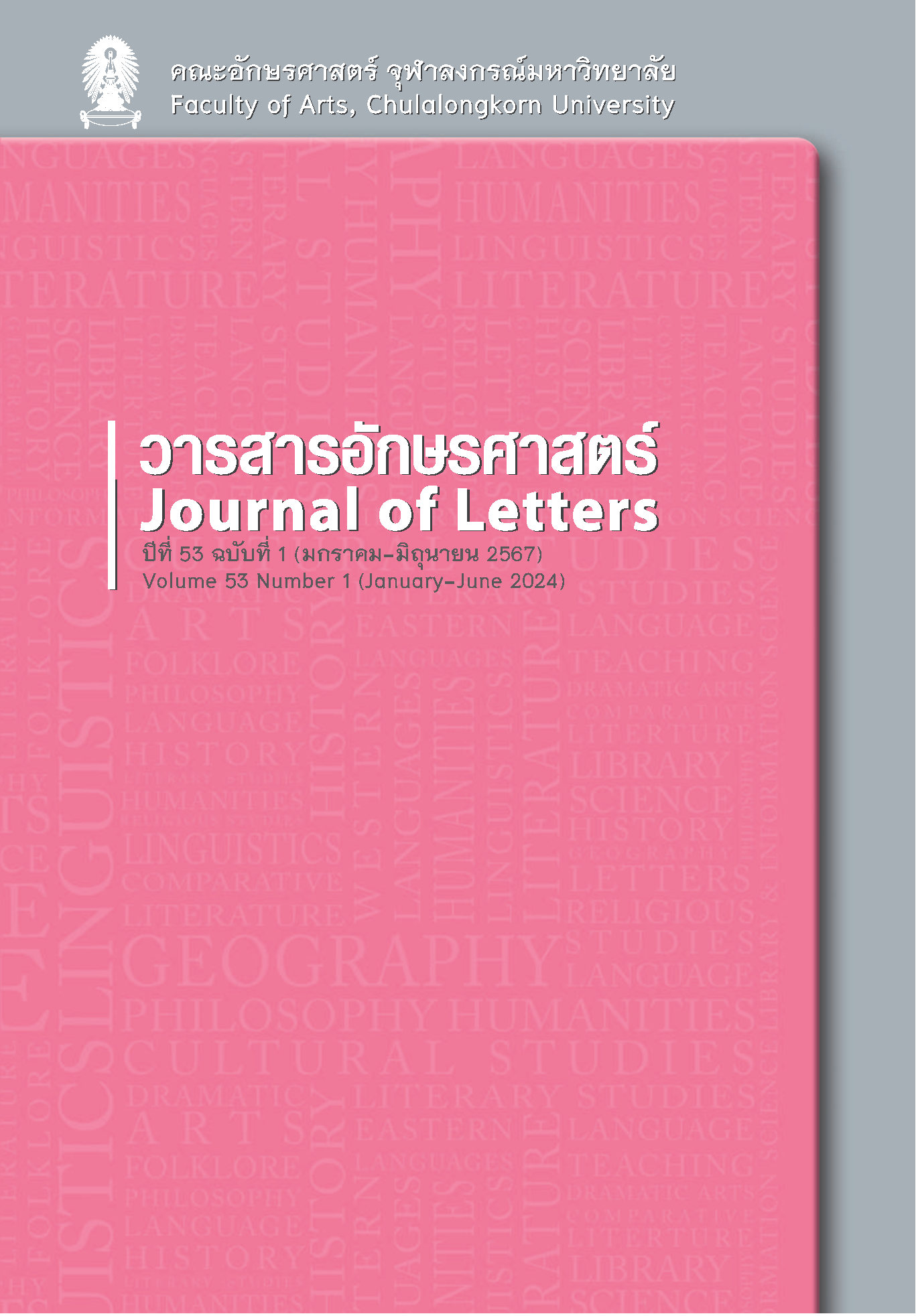A Greater Distance between the Readers and the Recounted Story in Salvatore Besso’s Travel Book:
The Function of the Picture Postcards
Abstract
This article analyses the scanned picture postcards in Salvatore Besso’s travel book with the aim to point out how they assume a crucial role in changing the main theme of the narrative on Siam in this book. From two main themes that run along together in the written narrative, exotism of Siamese culture and the recognition that Siam gained from Western nations, the scanned picture postcards lead the readers to focus particularly, if not only, on the first theme. This article seeks to shed more light to the significance of intermedial perspective in delving into subtle motives in cultural encounters. The intermediality at work in this study concerns the interaction between photographs and words that represents the interaction between Western culture as the content creator/audience and Siamese culture as the created content.
References
ภาษาไทย
Anek Nawikkamun เอนก นาวิกมูล. (1987). Thai rup mueang Thai samai raek ถ่ายรูปเมืองไทยสมัยแรก [Early Photography of Thailand]. Sangdad.
Kannika Chansaeng กรรณิกา จรรย์แสง. (2015). Banthuek kan doen thang khong Henri Mouhot nai ratcha anachak Siam Kamphucha Lao lae Indochin ton klang suan uen uen บันทึกการเดินทางของอ็องรี มูโอต์ ในราชอาณาจักรสยาม กัมพูชา และอินโดจีนตอนกลางส่วนอื่น ๆ [Travelogue of Henri Mouhot in Siam, Cambodia, Laos and other central parts of Indochina]. Matichon.
Nakrob Moonmanas นักรบ มูลมานัส. (2022). Len rae plae phap: prawattisat Siam chak bueang lang phap thai เล่นแร่แปลภาพ: ประวัติศาสตร์สยามจากเบื้องหลังภาพถ่าย [Early photography of Thailand]. Sangdad.
ภาษาต่างประเทศ
Barthes, R. (1983). Camera Lucida: Reflections on photography. Cape.
Behdad, A. (2016). Camera Orientalis: Reflections on photography of the Middle East. The University of Chicago Press.
Behdad, A., & Gartlan, L. (2013). Photography’s Orientalism: New essays on colonial representation. Getty
Research Institute.
Benjamin, W. (1968). The work of art in the age of mechanical reproduction. In Illuminations (pp. 219-253). Fontana.
Berger, J. & Mohr, J. (1982). Another way of telling. writers and readers.
Besso, S. (1913). Siam e Cina. L’incoronazione del re del Siam e i giorni della Rivoluzione Cinese. Tipografia nazionale editrice.
Burke, P. (2001). Eyewitnessing the uses of images as historical evidence. Reaktion Books.
Burns, P. M. (2004). Six postcards from Arabia: A visual discourse of colonial travels in the Orient. Tourist Studies, 4(3), 255-275. https://doi.org/10.1177/1468797604057327
Caple, H. (2013). Photojournalism: A social semiotic approach. Palgrave Macmillan.
Davis, B. (1987). Postcards of Old Siam. Times Edition.
de Duve. (1978). Time exposure and snapshot: The photograph as paradox. Photography, 5, 113-125. https://doi.org/10.2307/778649
Hall, S. (1997). Representation: Cultural representations and signifying practices. Sage.
Ivey, B. (2022). Virtual returns: Colonial postcards online and digital ‘nostalgérie’ among the former European settlers of Algeria. Humanities & Social Sciences Communications, 9(112), 1-8. https://doi.org/10.1057/s41599-022-01134-3
Kürti, L. (2004). Picture perfect: Community and commemoration in postcards. In A. I. Alfonso, L. Kurti, & S. Pink (Eds.), Working images: Visual research and representation in Ethnography (pp. 43-65). Routledge.
Klich, L. (2019). Circulating Lo Mexicano in Mauricio Yáñez’s postcards. In T. Zanardi & L. Klich (Eds.), Visual typologies from the early modern to the contemporary (pp. 150–165). Routledge.
Langbehn, V. (Ed.). (2010). German colonialism, visual culture, and modern memory. Routledge.
Mouhot, H. (1864). Travels in the central parts of Indo-China (Siam), Cambodia, and Laos during the years 1858, 1859, and 1860 (Vol. 1). John Murray. https://www.gutenberg.org/files/46559/46559-h/46559-h.htm
Norman, H. (1895). The peoples and politics of the far East: Travels and studies in the British, French, Spanish and Portuguese colonies, Siberia, China, Japan, Korea, Siam and Malaya. T. Fisher Unwin.
Osborne, P. (2000). Travelling light: Photography, travel and visual culture. Manchester University Press.
Said, E. (1978). Orientalism. Penguin.
Samson, L. (2019). Photography and forgery in Early Capitalist Siam. Technology and Culture, 60(3), 795-815. https://doi.org/10.1353/tech.2019.0073
Silapavithayadilok, P. (2017). L'immagine dell'Estremo Oriente Di Salvatore Besso [Unpublished master's thesis]. Università Degli Studi Di Firenze, Italy.
Smith, L. E. & Poolaw, L. (2016). Postcards. In H. Poolaw (Ed.), Photographer of American Indian Modernity (pp. 93-113). University of Nebraska Press.
Sontag, S. (2004). Regarding the pain of others. Penguin.
Topping, M. (2016). Travel writing and visual culture. In C. Thompson (Ed.), The Routledge companion to travel writing (pp. 78-88). Routledge.
Vokes, R. (2010). Reflections on a complex (and cosmopolitan) archive: Postcards and photography in Early Colonial Uganda, c.1904–1928. History and Anthropology, 21(4), 389-390. https://doi.org/10.1080/02757206.2010.520888
Downloads
Published
How to Cite
Issue
Section
License

This work is licensed under a Creative Commons Attribution-NonCommercial-NoDerivatives 4.0 International License.
Copyright and plagiarism
Authors are responsible for obtaining permission to use copyrighted materials from copyright owners. Authors are responsible for observing requisite copyright law when quoting or reproducing copyrighted materials. Quotations and reproductions of content from other published sources must be accompanied by a reference and all sources should be clearly listed in the references section. Quotations and reproductions of content from external sources without due attribution could be considered a severe infringement of academic conduct and may constitute a legal offence under the Copyright Act of B.E. 2537. Any legal ramifications arising from the infringement of copyright regulations would be the sole responsibility of the author(s).



